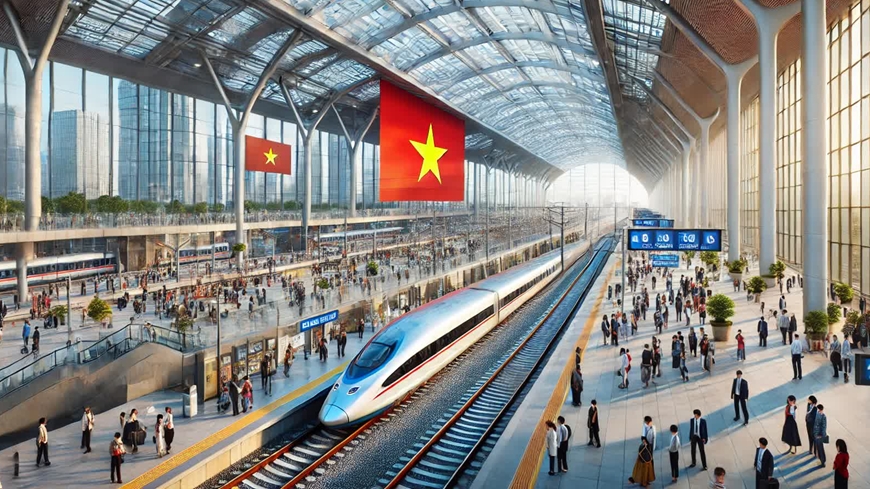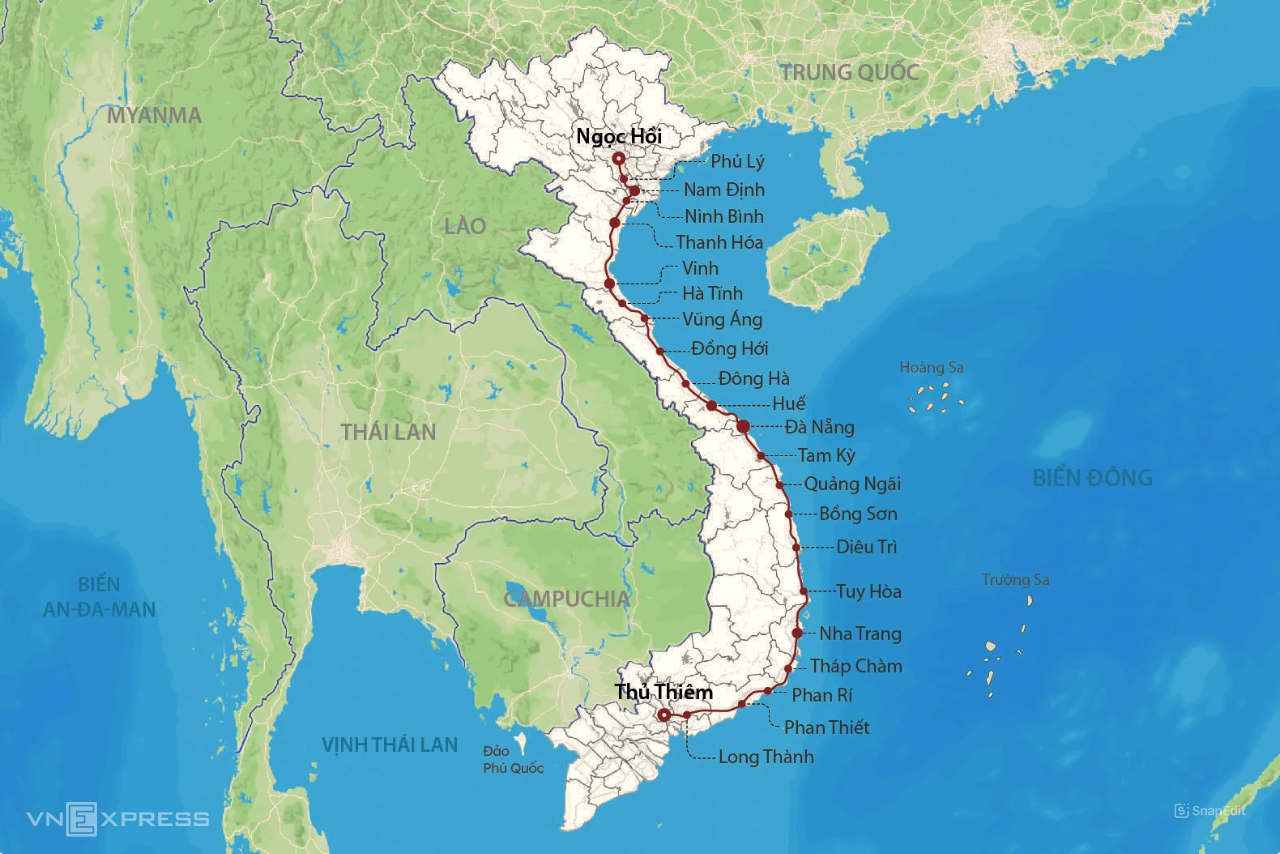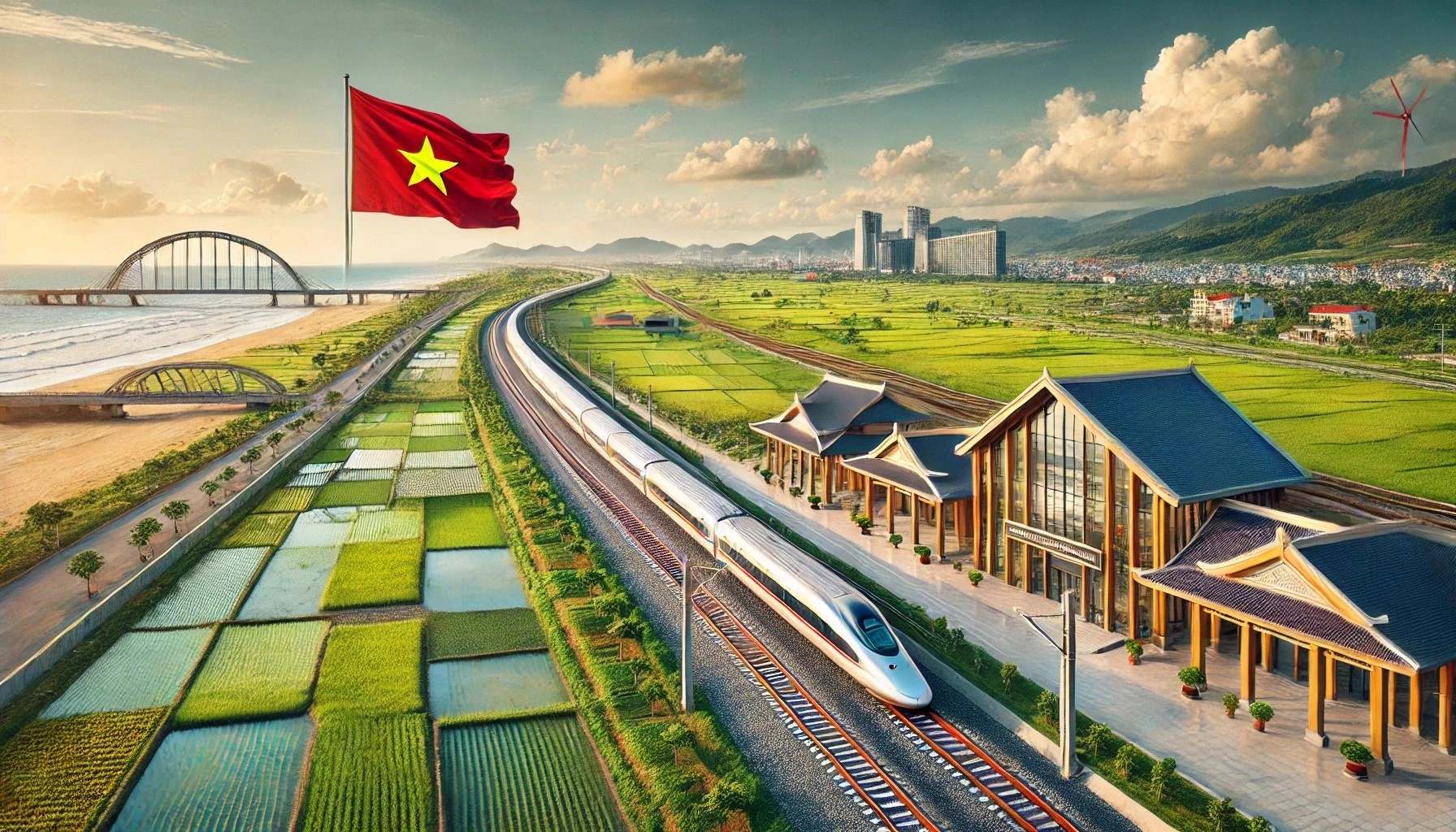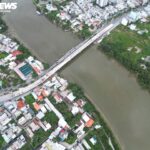
Delegate Hoang Van Cuong: There is no reason to skip Nam Dinh station on the high-speed North-South railway line.
High-speed railways must connect population centers, especially those with limited access to air travel.
The proposed route for the high-speed North-South railway line spans approximately 1,541 kilometers across 20 provinces and cities, including 23 passenger stations and 5 freight stations. However, there are concerns that the route, as it stands, does not follow the straightest possible path when passing through Nam Dinh province.
Sharing his perspective with Dan Tri newspaper, Delegate Hoang Van Cuong from Hanoi emphasized that the primary purpose of this railway line is to connect people in populous regions with limited access to air travel services. “The goal here is not to have the fastest train route between Hanoi and Ho Chi Minh City,” he stated, “but rather to connect population centers, especially those that are not well-served by air travel, and enable faster travel.” Mr. Cuong went on to express his opinion that constructing a high-speed railway line between the North and the South is meant to address the connectivity needs of densely populated areas.
“If we neglect this aspect in favor of achieving the fastest possible travel time between Hanoi and Ho Chi Minh City,” he continued, “we are mistaken in our understanding of this mode of transportation as a competitor to air travel.”
There is no justification for bypassing Nam Dinh station.
Delegate Hoang Van Cuong reiterated that the purpose of building a high-speed railway is not to rival air travel but to create a complementary transportation system. For instance, individuals traveling from Hanoi to Ho Chi Minh City who prioritize speed would opt for air travel. However, if someone needed to get from Nam Dinh to Ha Tinh more quickly, they could utilize the high-speed railway. In this way, the railway would serve as a supplement to air transportation.
Mr. Cuong also brought up historical considerations, noting that the North-South railway line from the French colonial era was designed to curve eastward to reach the city of Nam Dinh. Given these historical and contemporary factors, Delegate Cuong asserted that there is no valid reason to exclude Nam Dinh station from the high-speed North-South railway line.

Given the historical and contemporary factors, Delegate Cuong asserted that there is no valid reason to exclude Nam Dinh station.
Omission of the Nam Dinh station would result in additional costs of approximately 1,632,960,000 USD.
According to calculations by the Ministry of Transport, altering the route to connect to the center of Nam Dinh city would increase investment costs by approximately 476,330,000 USD and operational costs by about 20,360,000 USD (over a 30-year project cycle). However, if the Nam Dinh station is not constructed, the cost of traveling from the city center to Phu Ly or Ninh Binh stations is expected to increase by approximately 1,632,960,000 USD.
In a statement to the Ministry of Planning and Investment, the Ministry of Transport also noted that Nam Dinh city is planned to have a population of 600,000 by 2040 and will serve a larger population, including nearby areas in the Red River Delta region such as Thai Binh and Hung Yen, totaling approximately 4 million people.
The route of the high-speed railway line through Nam Dinh city has been designed to align with national, regional, and provincial planning. Nam Dinh is a transportation hub with significant transport demand (with an estimated 3 million passengers arriving at and departing from Nam Dinh station by 2050). The proposed route through 20 localities along the North-South corridor, including Nam Dinh, has been approved by the Politburo and the Central Committee of the Communist Party of Vietnam on September 20.
Therefore, the Ministry of Transport recommends retaining the current route through Nam Dinh. In the next step, the Ministry will direct the investor to further optimize the route to achieve the straightest path possible.

There may be minor adjustments to the station location along the section passing through Nam Dinh province. Graphic: Vnexpress
Minor adjustments to the station location may be made along the section passing through Nam Dinh province.
Mr. Dinh Mai Hung, Head of the Transport Construction Quality Management Division of the Nam Dinh Provincial Department of Transport, stated, “There may be minor adjustments to the location of the station on the North-South high-speed railway line as it passes through Nam Dinh province.”
He added, “The station does not necessarily have to be located in Hung Loc ward, Nam Dinh city, as mentioned in the pre-feasibility report, but rather, we should seek the most suitable location to achieve the straightest path possible.”
Specifically, the People’s Committee of Nam Dinh province has submitted documents to the Ministry of Planning and Investment and the Ministry of Transport regarding their agreement with the National Appraisal Council’s opinion on the route and station location through the province for the North-South high-speed railway project.
The documents also noted that in the process of preparing for the project’s investment, there have been significant changes to the pre-feasibility study report, including an increase in train speed from 250 km/h to 350 km/h. The Appraisal Council has requested that the Ministry of Transport provide clear technical justifications to ensure the straightest possible route, thereby reducing costs, especially for the section passing through Nam Dinh, while also maintaining the desired operating speed for the trains and creating new development spaces.
At the same time, the Ministry of Transport has been requested to coordinate with localities along the high-speed railway line to review and adjust the route and station locations for the project. The People’s Committee of Nam Dinh province agreed with the opinion of the National Appraisal Council to ensure smoother and more suitable operation for the overall project.
In the next step (the preparation of the feasibility study report), the province of Nam Dinh will coordinate with the Ministry of Transport to review and adjust the route and station location for the project section passing through the province.
Previously, the People’s Committee of Nam Dinh province had also submitted documents to the Ministry of Planning and Investment, expressing their opinion on the location of the Nam Dinh station along the North-South high-speed railway line.
The locality pointed out that the Red River Delta Region Planning with a vision towards 2050 has identified Nam Dinh city as the sub-regional center of the south, linked to the Quang Ninh – Hai Phong – Thai Binh – Nam Dinh – Ninh Binh coastal economic corridor. It is also a key transport hub for the North-South railway and the proposed Nam Dinh – Thai Binh – Hai Phong – Quang Ninh railway.
Adjusting the route and station location would not only disrupt the province’s planning system but also impact the socio-economic development and livelihood of the people in the locality and neighboring provinces such as Thai Binh, Hung Yen, Ha Nam, and Ninh Binh.
Therefore, the locality proposed maintaining the route and location of the Nam Dinh station on the North-South high-speed railway line in Hung Loc ward, as mentioned in the pre-feasibility report.

Nam Dinh Station – A connecting point for the North-South and Red River Delta corridors.
Nam Dinh Station – A connecting point for the North-South and Red River Delta corridors.
According to Quan Doi Nhan Dan newspaper, the route of the high-speed North-South railway line, as proposed by the consulting consortium in the pre-feasibility report, was designed based on ensuring the shortest distance between points while also meeting the technical requirements for the line’s profile and longitudinal slope.
The location of stations is a crucial factor in determining control points for high-speed railways. Essentially, when determining the location of a station within a region, it should meet the following criteria: At the economic and political center of each province or city through which the line passes, there should be a high-speed railway station to facilitate connections within that locality.
For additional stations, the following criteria should be considered: The distance between stations should be at least 30 kilometers, and the chosen urban areas for station locations should be of type III or higher.
Passenger stations are strategically placed in the urban areas of provinces, cities, and regional centers. These areas have high population concentrations and serve as transportation hubs for their respective regions. Each station location is carefully considered to ensure compatibility with the current situation and urban planning of each locality.
Station locations should provide convenient access to the urban center or areas with potential for future urban development following the TOD (Transit-Oriented Development) model. This approach ensures easy connectivity and attracts passengers. The distance between stations should also be appropriate to ensure efficient operation.
Additionally, there should be seamless connectivity with the public transport systems of the respective urban areas, especially the existing railway systems, to maximize the utilization of each system and form a comprehensive transportation network. The environmental and social impacts on the localities through which the railway line passes should be minimized, and the selected areas should have favorable terrain, geology, and hydrological conditions, requiring minimal land acquisition and reducing costs.
The location of freight stations is determined based on operational considerations, such as the need for coupling and uncoupling of freight cars and locomotive turning.

The North-South high-speed railway project includes 23 passenger stations, with an average distance of about 67 kilometers between stations. According to the consulting consortium, this distance is suitable for the designed speed of 350 km/h and aligns with the practical conditions of the localities and international experience (for speeds below 250 km/h, the average distance between stations is typically 30-50 km, while for speeds above 300 km/h, the average distance is 50-70 km).
After departing from Phu Ly station in Ha Nam province, the route follows the existing railway line and National Highway 21 towards Nam Dinh city. Following the Nam Dinh station, the line heads towards Ninh Binh province, crossing the Day River in the east of the Khanh Phu industrial zone (Ninh Binh city).
Due to the location of the Nam Dinh station being eastward of the North-South axis, the high-speed railway line will need to deviate from a straight path to pass through the Nam Dinh area.
The selection of the route and location of the Nam Dinh station has been carefully considered to ensure alignment with national, regional, and provincial planning, as well as to meet economic and technical requirements.
Summary
The $67.3 Billion Super-Project: Europe Watches Vietnam’s 1,541km Mega-Enterprise with Keen Interest
The European Ambassador to Vietnam expressed keen interest in and close observation of the National Assembly’s ongoing review of the key project.
“Presenting to the National Assembly: The Proposal for the High-Speed North-South Railway Project”
On the evening of November 6, at the National Assembly, right after the afternoon session of the 8th Session, the National Assembly Standing Committee met to discuss and provide opinions on the investment policy for the high-speed North-South railway project. The meeting was chaired by Mr. Nguyen Duc Hai, Vice Chairman of the National Assembly.
Unleashing the Potential: Unveiling the $824 Million ‘Super Port’ Project in Tran De
The People’s Committee of Soc Trang Province has requested that the Government consider providing funding support for the Tran De Port development. In the initial stage, the project is estimated to require over VND 19,000 billion in funding from the national budget.
High-Speed Rail Project: Transforming Vietnam with Far-Reaching Impact on 7-8 Key Sectors
Deputy Minister of Planning and Investment Tran Quoc Phuong stated that, based on initial assessments, the high-speed rail project is the largest-scale project to date, with an estimated total investment of nearly $70 billion. If this amount is invested from now until 2035, the project’s impact is expected to increase GDP by approximately 0.97 percentage points. Additionally, this project will have a direct impact on 7-8 sectors.





















